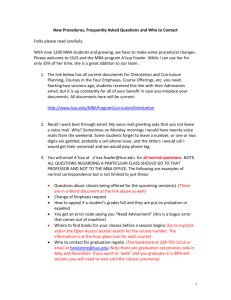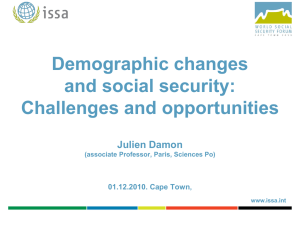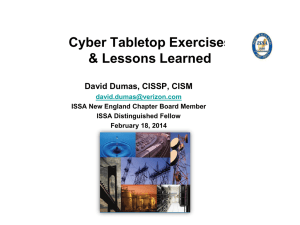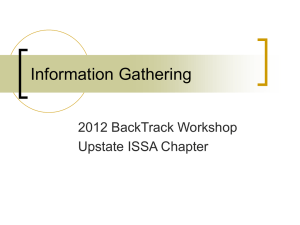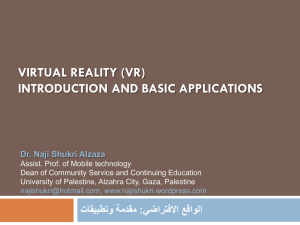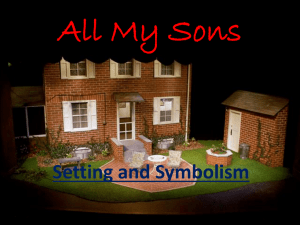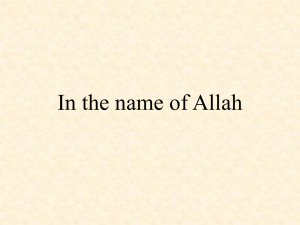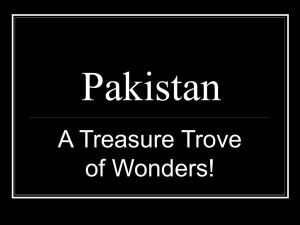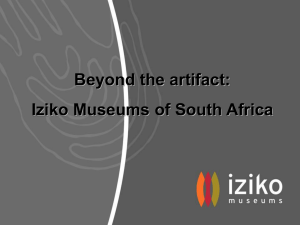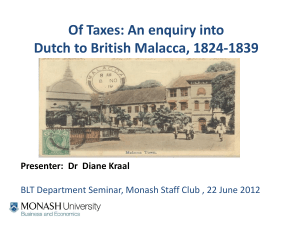Introduction to Shukri:themes, ideas, etc.
advertisement
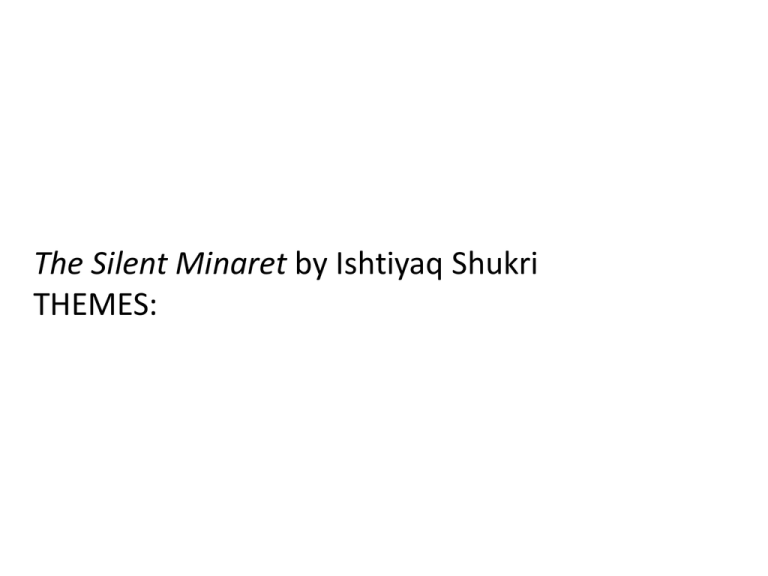
The Silent Minaret by Ishtiyaq Shukri THEMES: • In an interview, Ishtyiaq Shukri explains that his novel The Silent Minaret (2005)... is about the ‘alienation, disillusionment, anger and loss caused by the ‘war on terror’ in Britain” – but it achieves more than this. • Against the often powerful inscriptions of identity of such a restrictive and reductive discourse, particularly upheld by institutions of state and the media, the authors set the personal – the lived experience of their characters which in its complexity questions simple categorisations of identity in terms of culture and religion. • Setting characters with lives, feelings, struggles, loves, and fears (fiction) in a context of actual historical events and showing the many ways in which these events impact all sorts of people is the kind of writing which does what Steiner indicates only fiction is capable of. Shukri uses Issa and his struggles with power, visibility, and nations to get across some very strong points about perception. • • • • • • • • • • • • • Structure and Motifs Religion & ritual “Otherness” Walls and Barriers Amalgamation of peoples and religions Censorship/ Silence Forgetting/Remembering History/History Repeating Memory, Remembering vs. Forgetting Power/lack of access to history Invisible/Visibility and Disappearance Rebellion and subverting authority War/politics and destruction Disappearances & secrecy The intellectual in ‘exile’ Style • All of Issa’s dialogue are italicized not in quotes – Making him seem like a phantom or apparition • The epilogues in the beginning of each section – The Bookshelf (73) • What stands on Issa’s abandoned bookshelves? • What is the purpose of this excerpt? • The epilogues at the start of some chapters – A road map into our past (91) • Significance? Parallels? • Each chapter has a title (not simply a number: chapter 5) • We get to read selections of Issa’s manuscript/thesis • Poem at the beginning of novel • Flashbacks and Free Indirect Narrative style Structure • Begins with poem “When Cities Crack” echoes throughout narrative – Rhetorical questioning • “When cities crack, do stories too” – Do memories too – Do people too • Imagery of decimation – “like china heirlooms/smashing?” & “disintegrating” – “lifting/calling/tapping” • Reminiscent of bombed cities (Baghdad/Israel) – “brushing carefully dusting/ only ever finding/skeletons of silence” • Paleontology – searching for remains/ruins • Metaphor of South Africa – “mosaic pictures hobbled together from fragments” – “Then I trawl the fragments lying disarranged” • Religious imagery – Sacramental language • “upturned palms” and “ashen palms” VOC History • • • • • • • 1602 the prime companies of Holland merged to form a large company called "Vereinigte Ostindische Compagnie (VOC) The new company received a state charter which granted it sovereign rights the VOC was lord of over 150 trading vessels, 40 warships, 20,000 seamen, 10,000 soldiers and had nearly 50,000 civilians in its service VOC was unscrupulous: it created monopolies, destroyed local competitors and forced up prices for the most important spices by 180%. The East Indian quarters of the VOC were set up in Batavia on the island of Java, the Portuguese was driven out of Ceylon and Malacca and the first white colony was established in South Africa – Hobhouse, Henry: "Finally, the VOC ruled over eight foreign governments in Amboyna, Banda, Ternate, Macassar, Malacca, Ceylon, Java and on the Cape of Good Hope.” The later popular Dutch nickname for the once most influential company of the world was V(ergann) O(nder) C(orruptie) which means "Ruined By Corruption". Later the company fell due to serious • An ethnic community in SA made up of people who were brought by the VOC as slaves, political prisoners, and exiles • During apartheid they were moved from “District 6” to the Cape Flats (a coloured township) • Cape Malay was a subcateorgory of “Coloured” during apartheid • Typically Muslims – their language formed the root of Afrikaans Issa’s Disappearance • Issa perceives that those not in power are “disappeared” by those in power. • His “disappearance” makes a more poignant statement than any academic exploration/writing. He controls the conditions of his disappearance. • BUT: his thesis is left on the table. • His action draws in his family and those close to him from their “geographical and emotional distance” (Jayawardane 7). • Maybe even more importantly, it brings people (who were kept at a distance) into his perspective – it forces them to consider the poignant statement Issa has made by his silent disappearance. • As they attempt to solve the mystery, they consider every possible cause and effect, looking at history for clues History/Violent Night • History is a major backdrop to the story, providing some insight into Issa’s view of the world. • In 1667, the VOC brought the first prisoners to the Cape. All of them were Muslims, and all of them opposed the VOC business ventures in the East. • Sheikh Abdurahman Matahe Sha and Sheikh Mahmood were the first political exiles, rulers of Sumatra. • In 1694, Sheik Yusuf of Macassar (a.k.a. Abadin Tadia Tjoessoep) arrived in the Cape. He would be the most influential of these new political exiles. He is credited with being the grandfather of Islam in South Africa. Dreamer Schemer, History’s Cleaner • Past events are repeated • Resistance is met with intolerance and segregation via fear and the threat of disappearance • This happened in the beginnings of the Slave Trade and repeated with the way Muslims have been treated • “It was as much about forgetting as remembering. Not a single thought spared for how the exhibits came to be here in the first place. Chronic amnesia” (143). • History favors the winner, but: – Issa’s protest is revisionist; his whole thesis talks about how our knowledge of the VOC and the slave trade is portrayed in a way that favors the Europeans and he writes in a way that helps South Africans – He perceives the connection between the VOC and the US in their actions representative of a modern empire Religion & Ritual: • Cathemosdraquel Christian & Muslim – Amalgamation/fusion of the two • Frances contemplates this and imagines a more “whole” religion – Prays in both Arabic and English – meshing the two religions – “That it stands so close to the Catholic cathedral that from certain angles the two buildings almost seem as one. I rather like the sound of that” Yes Frances, imagine that, a sky that echoes simultaneously with azaan and the Angelus (77-8) – This appears to be a hopeful cry – why can mankind not simply accept both and live harmoniously, peacefully? • Issa Minaret – Issa tells Frances of its history and she wishes to see a tangible connection between the two religious traditions • The church-like mosque used to be the Roman temple of Jupiter, then the Basilica of St. John. It’s where John the Baptist is buried, a holy place for both Muslims and Christians. “I’ve thought about that one often since. I’d never heard of it. I wouldn’t have minded seeing it. Such a link.” A real cathemosdraquel, she thinks. (79) Religion & Ritual • The Issa (Jesus) Minaret is so called because it was believed that Jesus Christ, who is considered a prophet in Islam, will reappear at this place shortly before the day of judgment. The upper part of the Minaret that can be seen today was built in the Ottoman period after the earthquake of 1759, and the lower part is from the Memluk period. Source: E. Claire Grimes, A guide to Damascus, Avicenne Bookshop, 1997 Right: Issa Minaret Lower: Umayyad mosque Visibility and Power • History seems, to Issa, to be very “Euro-centric” (or centred around power/conquest). • Issa’s writing could be seen as Afro-centric or Muslimcentric. But in a way, it is “people-centric” • Issa contends that this sort of “forced invisibility” means that people will inevitably protest. • He’s interested in providing the stories of the conquered/those whose history was subsumed/disappeared by power. • He makes visible what was invisible, thusly shifting the power structures. He also challenges the manner in which power makes itself “invisible.” Censorship/Disappearance • The TRC Reports are read by Kagiso • Huge chunks of information are omitted/blacked-out – “…it strikes him that, more than a decade later, he has still not managed to fill in all the gaps inflicted upon him by a censorious dictatorial regime. The books not read, music not heard, histories not known… a part of his truthfully reconciled and liberated life.” (98) – He feels that he is “a collection of blank spaces, defined more by what I don’t know, than by what I do” (99) • This seems to be a recent revelation to Kagiso – yet this is what has been driving Issa all along (i.e.: his rebellion, and desire to know history as it actually happened) – Issa seems to be a more intellectualized version of this • Forget about maps. They don’t show things as they are. Asmara is in Eritrea. …That’s because it’s still a dream. Maps don’t show dreams either. Only nightmares. (59) • Kagiso recollects his friend saying this of the TRC – “A stage-managed whitewash… and Tutu wants us to ‘close the chapter on our past’, with this? When it castrates our leaders and diminishes our suffering…” (94) • Truth and Reconciliation Committee Abandonment/ Disappearance • SA citizens often turned up missing → TRC • SA citizens often abandoned their families to attempt to move up (racially/socially) during Apartheid or due to political agendas • Issa abandons his family for his politics – “Issa lifted a rucksack onto his back and made for the front door, determined to defy Ma Vasinthe… Issa swung around and started running toward the back door… [was] carried away in an expensive motorcade of defiant resistance.” (102-3) • Issa abandons his manuscript/thesis – “By the time the waiter turns around… his eyes settling on the empty seat in the corner behind the mashrabeya screen, the wound-up pipe, the serviette, folded neatly next to the empty glass the abandoned manuscript, Issa has already slipped through the door”(71-2) We can control people by controlling their access to information • “I did not want anybody to know that I could read. I half consciously realized even then that this was the dangerous moment. I was safe so long as I could not read,” – Graham Greene (Shukri, 73) • People disappear and no one knows what happened to them – total lack of information • Rebellion/ Subversion of Authority Allusions to (often Issa’s) Pink Floyd’s The Wall album – Seems as though this would be a banned album, part of the “music not heard” – Heavy subversion of authority theme “Hey, teacher, leave them kids alone” “all in all you’re just another brick in the wall” School? I’m sorry, Ma, but if you mean that bigoted white liberal bourgeois nest you send us to every day, you can forget it (102) But I like deserts Teacher. …They’re deserts of water. And ‘the desert is an ocean in which no oar is dipped’. (57) • Influence of multiple rock songs/albums including Purple Rain Prince and the Revolution – the song Purple Rain is a symbol for heaven/the afterlife • Issa’s political activism (righteousness) and subsequent unexplained disappearance alluded to via these references – “… he recognized Issa, stained purple, staring at him from among his purple comrades.” (82) Barriers/Walls • Barriers have long been used as a means to keep people powerless, by limiting where they can go, what they can do, and with whom they can interact. • There seem to be many barriers in the novel, both real, physical barriers and metaphorical barriers. • What are some of the barriers you noticed? Were they overcome? How? Contradictions and Perspectives • This book operates on analyses and comparisons of many contradictions inherent in history – “A thesis that started out as history now reads like current affairs,” – Issa (Shukri, 67) – he feels this is also a moment of encounter in which a group will be depicted as violent, brutal, or barbaric because there is a resource this invading company wants (Jayawardane). – The “silent minaret” – “At home, minarets declare God’s greatness five times a day, but here they stand silent like blacked-out lighthouses,” – Issa (Shukri, 76) … and the concept of the mosque in Durban that is so close to the cathedral that they almost seem like one building (cathemosdraquel) - he’s constantly emphasizing that the three main religions build on each other’s history, and it is a holy land for all of them. – “What sort of society makes sentences out of such disparate words?” – Issa talking about words like “riot gear, metal battering ram, mosque; children, refuge, deportation…) (Shukri, 88)
